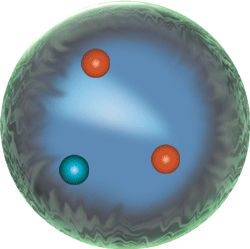|
|
|
|
|
2005 JLab News Release
|
||||||
G-Zero Experiment Spots Strange Quarks Influencing Proton StructureJune 17, 2005In research conducted at Jefferson Lab, nuclear physicists in the G-Zero collaboration have found that particles called strange quarks do, indeed, contribute to the proton's properties. Specifically, they've found that strange quarks help determine a proton's charge distribution and its magnetization. To some, the idea that strange quarks are integral in determining the properties of protons, one of the building blocks of the nucleus found in all ordinary matter, could seem, well, strange. That's because strange quarks typically aren't permanent residents of the proton. That title belongs to the two lightest of the six quarks: those labeled up and down. However, the strange quark, which is the next-lightest, may visit the proton on occasion by popping into and out of existence in the "quark-gluon sea" - a seething mass of particles created out of energy from the strong force.

There are six types of quarks (up, down, charm, strange, top, and bottom). The lightest quarks - called up and down - are the most common. Image: JLab In simple terms, a proton is built of three permanent quarks (two up and one down quark) that constantly swap particles called gluons. These gluons carry the strong force, so this swapping of gluons is what "glues" the quarks tightly together into protons, neutrons and other particles. The force is so strong, in fact, that you'll never find one quark alone. Instead, they're usually found bound together in pairs or triplets (like the proton). In the proton, the strange quarks appear in pairs, consisting of a strange quark and its anti-particle, the strange anti-quark. Pairs of any of the six quarks (up, down, strange, charm, bottom or top) and their anti-quarks may also appear. However, the G-Zero collaboration is looking for strange quarks, because it's thought that they would be the most likely to have a visible effect. Where do these strange quark pairs come from? They're created from energy that permeates space at the extremely minuscule level of quarks. Some of this energy is attributed to the strong force, in fact. And it's thought that more than 99% of the proton's mass actually comes from this strong force energy. Strange quarks are created from the strong force energy just like Einstein's famous E=mc2 equation predicts. Physicists prefer to say that this energy fluctuates into mass and then back to energy again. The result is the quark-gluon sea of particles that seem to pop into and out of existence. What G-Zero scientists want to know is if and to what extent strange quarks contribute to the structure of proton that they've suddenly appeared inside. 
This simple picture depicts pairs of strange quarks as they pop into and out of existence alongside the permanent quark residents of the proton. Nuclear physicists have found that strange quarks, though present for just tiny fractions of a second at a time, also contribute to the proton's properties. Image: JLab To find out, the G-Zero collaboration, an international group of 108 physicists from 19 institutions, staged a multi-year, multi-million dollar experiment at Jefferson Lab. According to Doug Beck, a professor of physics at the University of Illinois at Urbana-Champaign and the spokesperson for the G-Zero collaboration, one way to see these strange quarks is to measure them through the weak force.
Forces of Nature These electrons are packed with energy in the Lab's accelerator and are then sent into an experimental target. Some of these electrons will collide, or "interact," with the nuclei in the target. The electrons may interact with the nuclei either through the electromagnetic force or the weak force. G-Zero aims to take snapshots of the nucleus by measuring particles from each of these interactions and comparing them. "If we look with photons via the electromagnetic interaction, we see quarks inside the proton. And then, if we do it with the weak interaction, we see a very similar, yet distinctly different view of the quarks. And it's by comparing those pictures that we can get at the strange quark contribution," Beck says. The G-Zero physicists use a trick to calculate how many protons came from the weak force interaction and how many came from the electromagnetic force interaction. They alternated the spin of the electrons that they sent into the experimental target. This orientation of this spin is called polarization, and electrons may be polarized so that they spin along the direction that they're traveling or opposite. The electrons' polarization will not affect the number of protons knocked out of the target by the electromagnetic interaction, but it will affect how many protons are scattered by the weak interaction. Since the hydrogen nucleus consists of a single proton, G-Zero researchers send a polarized beam of electrons into a hydrogen target. "We run the beam with polarization in one direction, and we look to see how many protons are scattered. Then we turn the beam around, in polarization at least, and measure for exactly the same amount of time again and look to see how many protons are scattered," Beck says, "The relative difference in those counting rates tells us how big the weak interaction piece is in this scattering of electrons from protons. We compare it to the strength of the electromagnetic interaction between electrons and protons, and that gives us the answer that we're looking for."
What Strange Quarks Do in the Proton G-Zero allowed the researchers to extract a quantity representing the strange quark's overall contribution to both phenomena. "The data indicate that the strange quark contributions are non-zero over the entire range of our measurements," Beck says, "And there are a couple of points that overlap other measurements. They agree, so that's a good thing." The result comes from work performed by the G-Zero collaboration and was presented at a Jefferson Lab physics seminar June 17. However, by itself, the G-Zero result does not yet allow the researchers to separate the strange quark's contribution to the charge from its contribution to the magnetization. "There's another G-Zero run coming up in December, and that will help us to try to disentangle the contribution of strange quarks to this combination of the charge and the magnetization. So that will give us one more measurement that will allow us to look at those quantities separately," Beck says. G-Zero is a multi-year experimental program designed to measure, through the weak force, the strange quark contribution to proton structure. G-Zero was financed by the U.S. Department of Energy and the National Science Foundation. In addition, significant contributions of hardware and scientific/engineering resources were also made by CNRS in France and NSERC in Canada. To date, more than 100 scientists, 22 graduate students and 19 undergraduate students have been involved with G-Zero. Several other electron scattering experiments, including the SAMPLE experiment at MIT-Bates, the A4 experiment at the Mainz Laboratory in Germany, and HAPPEx at Jefferson Lab were also designed to study strange quarks in the proton.
More information on G-Zero Thomas Jefferson National Accelerator Facility’s (Jefferson Lab’s) basic mission is to provide forefront scientific facilities, opportunities and leadership essential for discovering the fundamental structure of nuclear matter; to partner in industry to apply its advanced technology; and to serve the nation and its communities through education and public outreach. Jefferson Lab, located at 12000 Jefferson Avenue, is a Department of Energy Office of Science research facility managed by the Southeastern Universities Research Association. content by Public Affairs maintained by webmaster@jlab.org updated June 17, 2005 |